
Related
Extended discussion with award-wining Mexican film director Diego Quemada-Diez, whose film “La Jaula de Oro,” or “The Golden Dream,” chronicles the story of two Guatemalan kids and one indigenous Tzotzil boy from southern Mexico as they attempt to traverse Mexico and the U.S.-Mexico border to reach the United States. The film is based on interviews Quemada-Díez conducted over six years in Mexico with hundreds of Central Americans and Mexicans attempting to migrate to the United States. We speak with filmmaker Diego Quemada-Díez about his process of making the film and what he hoped to convey. “I wanted to use the film as a mirror,” Quemada-Díez explained. “So we can look at ourselves and see what unites us, so that instead of building walls, we can try to build bridges, try to understand and feel empathy and realize that if we were in their situation, we would do exactly the same thing.”
Transcript
UNIDENTIFIED: [translated] Are you going to the United States?
JUAN: [played by Brandon López, translated] Yes. Run! We’re here in Arriaga. We’ll travel to Mexicali. From Mexicali, we’ll travel to Los Angeles. That’s really awesome, right?
SARA: [played by Karen Martínez, translated] And you, Juan, what do you want up there?
JUAN: [translated] If I tell you, it won’t come true, bro. I no longer want to travel with that Indian.
SARA: [translated] All three of us are leaving. The three of us. You get that?
POLICE OFFICER: [translated] So you wanted to become rich in the U.S.? Well, you won’t get there now. Let’s go!
SARA: [translated] Hey, Juan, where do we go from here?
UNIDENTIFIED: [translated] Everyone is going to give me a phone number in the United States. If you cooperate, you’ll get out of here alive.
JUAN: [translated] I feel as if I had a zoo in my stomach from the excitement of going over to the other side, as if a whole bunch of animals were running all over my body. Everything is going to be fine, and we’ll get to where we want.
AMY GOODMAN: The trailer to La Jaula de Oro, The Golden Dream or The Golden Cage. As leading Republican presidential candidate Donald Trump sparks controversy for comments calling Mexican immigrants “rapists” and proposing building a massive wall along the border, the film shines a light on the true reality of Mexican and Central American migration to the United States. The New York Times writes, Golden Dream, quote, “unblinkingly observes the hardships endured by these vulnerable children, who are harassed by soldiers and policemen, roughed up, robbed, forced to work as drug mules and imprisoned by kidnappers.”
We welcome you, Diego Quemada-Díez, to Democracy Now! It’s great to have you with us. Congratulations on this remarkable film. Talk about what led you to make this, and tell us the story.
DIEGO QUEMADA-DÍEZ: Well, I was doing a documentary in Mazatlán, in Sinaloa, in Mexico, and I became very good friends with a taxi driver, and he invited me to live at his home. This was back in—at the end of 2002. And his home with his family was by the railroad tracks. So every day the train would arrive, and we would give them food and water, and they all told us their stories. And they asked us to tell others. So, I felt that they were heroes, that they were very brave people that were sacrificing their lives, because many of them die in the journey trying. And I felt their story had to be told to others, and to do it in a sort of epic poem, like if—like making them heroes.
So, through the years, I gathered over 600 testimonies from women, children and men. I was hanging out—well, going to shelters in the border, shelters along the journey in Mexico, also in the communities in Guatemala. And also I went to prisons and shelters for kids here in the United States. And then I concentrated all the testimonies in four kids, and—in order to talk about also what kind of opportunities that we’re giving to our young kids and what kind of world that we’re giving them to realize their dreams. And, yeah, I wanted to talk about how it doesn’t make any sense to do this policy of militarization of the borders and the criminalization of migrants and the incarceration of migrants, which in the United States is around half a million people, whose only crime was to cross a border.
JUAN GONZÁLEZ: I wanted to ask you—your film, it’s not a documentary, it’s a fictional film but based completely on the reality of the experience that people are going through, and it’s also not with professional actors. That was—and the other thing that struck me is that you chose to deal with the Central—with Guatemalans, so that you show the enormous trek through Mexico first, before people even get to the border, and the dangers that people go through the long, long journey from Central America up through Mexico, as well.
DIEGO QUEMADA-DÍEZ: Yeah, you know, I was very shocked when I read an interview by John Ford in 19—that he did in 1939 and after Stagecoach. And he said, “In the future, people will not make films like this. In the future, people won’t work—filmmakers won’t work with big film stars and big budgets. They will go to the communities, listen to the people and then find out what stories need to be told, and then they will write the scripts based on that. And once they have the scripts, they will go back to the communities, and the same communities will act them.” And so that inspired me a lot, and also neorealist cinema, you know, from the Italian era to also Rodrigo D from Colombia and a few other films that have to do with our contemporary reality. And you try to take the best from fiction and the best from documentary. So you take dramatic structure, the fact that you can re-enact the events instead of people telling you about them.
And you can have a bigger budget so you can actually make the film like a—because I wanted it to be like—to make like an epic, so I wanted it to be a much bigger film that could really—that in a way was also an adventure film, that it had a very social, conscious layer to it, but at the same time it was also entertaining, and it was also spectacle, that people could be entertained by watching it, but at the same time provoke thought, provoke reflection about this issue that we’re living nowadays, and use film as a mirror, you know, to—so we can all look at ourselves and see what—also what unites us, instead of building walls, try to build bridges and try to understand and feel empathy and realize that if we were in their situation, we would do exactly the same thing.
AMY GOODMAN: Can you set up this clip for us? This is a clip from La Jaula de Oro, which means The Golden Dream or The Golden Cage.
DIEGO QUEMADA-DÍEZ: So, in this scene, what happened is that I try to take all the elements from each of the testimonies. I couldn’t put them all, but one them that really shocked me was this girl that told me that in order to start the journey, her mother cut her hair, put this band around her breasts and dressed her like a boy in order to survive this journey, in order not to be raped. And eventually, they never arrive. But she told me that story, and another woman told me, you know, “I will take the birth control pill, because we know we’re going to get raped, or we know we’re going to have to have sexual relationships with immigration officers or different people on the way in order to—as a passport.” So the girl at the beginning of the film gets dressed as a boy, cuts her hair and takes the pill. So it’s like she’s getting ready for—in a way, for this journey that she already knows what’s going to be.
So when—another story that another migrant told me is that the train—they stopped the train. They brought down everyone. They put them in a line. And then these guys were passing by, and they were just taking the girls out of the line, and they were putting them in a trunk—in a truck. And then they would take them away, and that’s the end of the story, in a way, because I wanted to create a big shock, to really feel what it is like to lose someone.
And in general, with the film, just we go with very—this very anonymous news. You know, like when we played the film in Italy, in Ferrara, at the Internazionale film festival, there were a lot of journalists there. And the day we played the film, 350—it was the day that in Lampedusa 350 died in the boat. And everyone was so shocked, you know, and we talked for like four hours. And they were saying, you know, like, by giving a face to this anonymous news—there are just numbers, and people are just getting used to it—then the impact is much bigger. So that’s the idea behind it.
AMY GOODMAN: Let’s go to a clip from La Jaula de Oro.
SMUGGLER: [translated] Over to the truck! Over to the truck, and make it fast! Now! Come on! Get in! Come on! Get in!
MAN WITH MACHETE: [played by Luis Alberti, translated] You. Come here. This one is a female. Let’s check. Of course! Take a look, boss. You thought we were idiots, right? Take it easy. Everything is going to be fine. Don’t move. Look at this. She must be a virgin.
AMY GOODMAN: That’s a clip from La Jaula de Oro. We are joined by the filmmaker, Diego Quemada-Díez. Can you talk, Diego, about how you chose your four main characters?
DIEGO QUEMADA-DÍEZ: Yeah, I wanted to talk about migration as an economic issue, and I wanted to give voice to the people that normally migrate. So we went looking for them at zone three, zone 18, Ciudad Peronia, all these places, in all the slums in Guatemala City, and which—they’re normally also called criminals, right? They’re called red zones, and everyone says, you know, “Everyone there, they’re just criminals.” And suddenly we found this incredible artist there. We saw over 6,000 children. And there were—all of them were artists, no? And the lead kids are painters. They do graffiti. They dance. They sing. The girl wanted to be an actress, and she played—she did theater.
So we went looking for them in those neighborhoods. And out of those—you know, I would ask them basically to dance. I would give them a piece of music and ask them to dance, to see their connection with their body. And I would also give them a situation, so they would improvise. And then, of course, I would ask them if they wanted to go to the United States. And the lead kid, for example, he told me yes. He was wearing a U.S. cap, and he said, “I want to be famous, and I want to be the protagonist of this movie.” So, in a way, it became like they had a dream, and I had a dream, you know, and we interchanged the dream.
And then, to look for the indigenous character, I wanted someone who didn’t speak any Spanish at all, and we looked for him in the mountains in Chiapas. We were doing that, thanks to some cultural organization called CELALI. They’re also Tzotzil. And he appeared with a Rambo T-shirt, I remember. He was the first in the line that day at 7:00 in the morning. And I had been over three months already in the mountains looking for him, and I couldn’t find him. And they were all with cellphones, and they all completely are changing. And they—in a way, they despise their own culture and their own language, because that’s what the society is doing. It’s looking down on them all the time. And finally, it was him. He appeared. He was wearing his Rambo shirt, and he said—he told me, “I want to be the protagonist of the movie. I want to be in one of those movies where there’s a lot of gunshots and explosions, like in the Jean-Claude Van Damme and Rambo movies.” And I thought, “Wow, it’s incredible.” And he had these contradictions, you know? And he was barefoot, and he was—he’s Chauk in the film. And he wanted to leave his town. He also said, “I want to get out of here.” So, I just put them together, and it worked very well, you know.
But the way I filmed it is that I—they didn’t know the story. It’s a method I learned with a British director, with my master, with Ken Loach, that I worked with him in three films. And the way he works is that he does not show the script to the actors. And you film in chronological order. So we started in Guatemala, and we ended in the United States. And you go in the order of the script. And five minutes before shooting the scene, I would read them the scene, and I would say, you know, “How would you say this that’s here as written?” And then they—at the beginning it was hard for them, but later it was easy.
JUAN GONZÁLEZ: And the reason for not letting the actors see the entire script beforehand?
DIEGO QUEMADA-DÍEZ: It’s so they live an experience, so they live—so it becomes life, so you’re filming life instead of acting, so it becomes a real experience. And it’s really a trust, you know, from them to you. I mean, you have to gain their trust, and they have to know that you’re going to be always protecting them. But it’s like jumping out of—into the unknown. Like—
AMY GOODMAN: So it’s their words, not yours?
DIEGO QUEMADA-DÍEZ: Yeah, it’s their words, yeah. I mean, the objective of the scene obviously is written in each scene, but the way it’s said is the way they speak. So it’s a great opportunity also to see the very specific dialect they speak in the zone three in Guatemala, which is a—because I love Pasolini and the use of dialects. And I think it’s—that’s the spirit of the film, is giving voice to people that don’t normally have it.
AMY GOODMAN: So you choose these four main actors out of 6,000. They’re not actors, they’re kids.
DIEGO QUEMADA-DÍEZ: Yeah.
AMY GOODMAN: And they won best acting ensemble at the Cannes Film Festival.
DIEGO QUEMADA-DÍEZ: Yes, yes, yes. Well, we did a workshop before, because everybody was very nervous. You know, of course, a film production that relies on four non-actors, everyone was kind of freaking out. But so, you know, I said, “OK, let’s do a workshop.” So we prepared them. Because every actor has gone to some kind of acting school, so I said, “OK, let’s do an intensive acting school.” And we did. And I called Fátima Toledo, who did Pixote and City of God. She’s in São Paulo. And she loved my short film, and she liked the script very much, so she came over about 10 days. And the rest of the time we applied her method, which is a very physical—it’s a mixture of bioenergetic and Kundalini yoga and games and very loaded.
And the objective of the workshop is, first of all, to get a commitment from them, so you don’t start filming and after five days they say, “Oh, that was nice, but, you know, I’ve got to go.” And they get used to, you know, waking up at 6:00 in the morning or 5:00 in the morning and doing the job and knowing that the whole production relies on them and knowing that it’s a commitment, that it’s a job, and it’s an exchange, and they’re expected to do the job. Also, you want the camera to become invisible. We did a lot of exercises with maintaining the gaze in the other, and the camera moving around. I was always there or my DP filming. And eventually the camera disappears.
And then you also do one—we also wanted them to trust themselves and to become very—to kind of flourish and blossom. And at the beginning, they were very weak. A lot of them were missing their parents and crying, because they never left their homes before. And eventually, as the weeks went by, they became very strong and very—and much more confident in themselves. But yeah, we didn’t really work on scenes. We just worked on physical stuff and on developing their intuition and their confidence. And eventually, yeah, the way—and right after the workshop, we went into the filming. And then they just started—they just became—I mean, themselves and the character became one. The character in the film is a mix between all the testimonies, my own life also and themselves.
JUAN GONZÁLEZ: And then, you did all the filming on—throughout the very territories that they were supposedly traveling through. How was that? Did you have much difficulty in moving up through Mexico and into the border, in terms of your locations?
DIEGO QUEMADA-DÍEZ: Well, it was extremely complicated, because we had 120 locations, and we were constantly moving. So I never watched the footage. So, you know, we were filming a scene, maybe two, three hours, then you’re moving to the next town. And, you know, it was very, very intense. And then, the way I wanted to do it is also to always cast the people from the villages and the real migrants that travel on the train. So we had a crew that was—that I learned this from a film called In This World by Michael Winterbottom, the one about the kids going from Afghanistan to London. And we had a crew that was three, four days ahead of us. And they were casting extras. So by the time we would arrive to a town, they already had, you know, the migrants or the people from the villages, and then we would incorporate them into the film. We would give them a salary, food, water and a safe train to travel, because, I mean, the research part, when I did the research part, that was extremely dangerous. I mean, like, sometimes I was accompanied, accompanied by a journalist, you know, someone that knew a lot about the places to go, and sometimes I was on my own. We had, you know, intents of kidnapping and guns on my head. You know, it was—it got pretty intense. But by the—
AMY GOODMAN: What do you mean? Can you tell us one situation?
DIEGO QUEMADA-DÍEZ: Well, there’s a scene in the film, the scene with Vitamina. That’s based on something that happened to me in Mazatlán. And he thought—I was doing this documentary, and at the same time I was researching the La Jaula de Oro, and he thought I was filming him. And then he came up, you know, with a gun, and they were—we were surrounded by about three cars with AK-47s, and they were going to take us to—and they said, you know, “You’re going now. You’re going to die now.” And they were going to take us to an empty lot to get shot. And—yeah, I don’t know. I mean, we were trying to talk to him, and the guy would not—would not make any—you know, he would not listen, because he was so much on cocaine. And eventually, after 15 minutes, I told him, you know, “Can I just show you what I was filming?” And he gave me the camera back, and I pressed rewind, and I hit play, and the guy saw that I was just filming, you know, kids playing in the street and B-roll. And he just gave me a tap on my back and said, you know, “You should have told me, you know? I should have known what you were doing. You can’t just come up to my neighborhood and start filming here.”
AMY GOODMAN: Finally, the title of your film, La Jaula de Oro, it means The Golden Dream, but also it means The Golden Cage. Explain.
DIEGO QUEMADA-DÍEZ: Well, La Jaula de Oro is the title of a song by Los Tigres del Norte. It talks about—it’s a very, very famous song to all the migrants. And the migrants are—it’s a classic song that represents the trap that the United States has become for many. You know, you go there for the gold, and once you’re inside, you cannot get out because of the current legislation. If there was something like, you know, you could get a three-month visa, you could come here, do the job, go back to your town, that’s what migrants want. You know, the migrants don’t want to be trapped in here. You know, they have family over there. They miss their towns. It would be a very easy solution, at least temporarily—I mean, the better one would be to develop the economy so people don’t need to migrate.

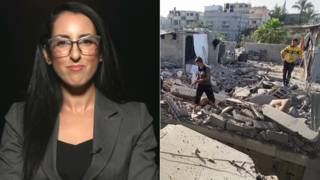
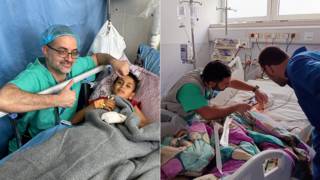
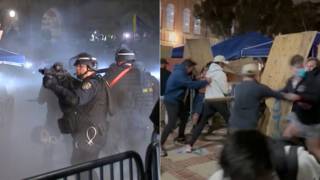
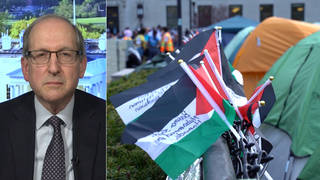
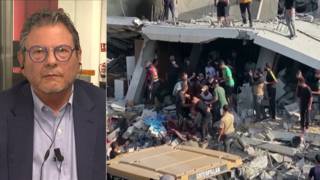





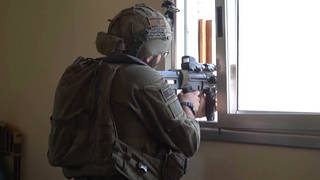
Media Options